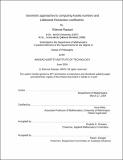| dc.contributor.advisor | Sara Billey. | en_US |
| dc.contributor.author | Rassart, Étienne, 1975- | en_US |
| dc.contributor.other | Massachusetts Institute of Technology. Dept. of Mathematics. | en_US |
| dc.date.accessioned | 2005-05-17T14:44:18Z | |
| dc.date.available | 2005-05-17T14:44:18Z | |
| dc.date.copyright | 2004 | en_US |
| dc.date.issued | 2004 | en_US |
| dc.identifier.uri | http://hdl.handle.net/1721.1/16632 | |
| dc.description | Thesis (Ph. D.)--Massachusetts Institute of Technology, Dept. of Mathematics, 2004. | en_US |
| dc.description | Includes bibliographical references (p. 119-125). | en_US |
| dc.description | This electronic version was submitted by the student author. The certified thesis is available in the Institute Archives and Special Collections. | en_US |
| dc.description.abstract | Using tools from combinatorics, convex geometry and symplectic geometry, we study the behavior of the Kostka numbers and Littlewood-Richardson coefficients (the type A weight multiplicities and Clebsch-Gordan coefficients). We sh w that both are given by piecewise polynomial functions in the entries of the partitions and compositions parametrizing them, and that the domains of polynomiality form a complex of cones. Interesting factorization patterns are found in the polyomials giving the Kostka numbers. The case of A3 is studied more carefully and involves computer proofs. We relate the description of the domains of polynomiality for the weight multiplicity function to that of the domains for the Duistermaat-Heckman measure from symplectic geometry (a continuous analogue of the weight multiplicity function). As an easy consequence of this work, one obtains simple proofs of the fact the Kostka numbers, and Littlewood-Richardson numbers are given by polynomial functions in the nonnegative integer variable N. Both these results were known previously but have non-elementary proofs involving fermionic formulas for Kostka-Foulkes polynomials and semi-invariants of quivers. Also investigated is a new q-analogue of the Kostant partition function, which is shown to be given by polynomial functions over the relative interiors of the cells of a complex of cones. | en_US |
| dc.description.abstract | (cont.) It arises in the work of Guillemin, Sternberg and Weitsman on quantization with respect to the signature Dirac operator, where they give a formula for the multiplicities of weights in representations associated to twisted signatures of coadjoint orbits which is very similar to the Kostant multiplicity formula, but involves the q = 2 specialization of this q-analogue. We give an algebraic proof of this results, find an analogue of the Steinberg formula for these representations and, in type A, find a branching rule which we can iterate to obtain an analogue of Gelfand-Tsetlin theory. | en_US |
| dc.description.statementofresponsibility | by Etienne Rassart. | en_US |
| dc.format.extent | 125 p. | en_US |
| dc.format.extent | 1097553 bytes | |
| dc.format.extent | 1083189 bytes | |
| dc.format.mimetype | application/pdf | |
| dc.format.mimetype | application/pdf | |
| dc.language.iso | eng | en_US |
| dc.publisher | Massachusetts Institute of Technology | en_US |
| dc.rights | M.I.T. theses are protected by copyright. They may be viewed from this source for any purpose, but reproduction or distribution in any format is prohibited without written permission. See provided URL for inquiries about permission. | en_US |
| dc.rights.uri | http://dspace.mit.edu/handle/1721.1/7582 | |
| dc.subject | Mathematics. | en_US |
| dc.title | Geometric approaches to computing Kostka numbers and Littlewood-Richardson coefficients | en_US |
| dc.type | Thesis | en_US |
| dc.description.degree | Ph.D. | en_US |
| dc.contributor.department | Massachusetts Institute of Technology. Department of Mathematics | |
| dc.identifier.oclc | 56020080 | en_US |
